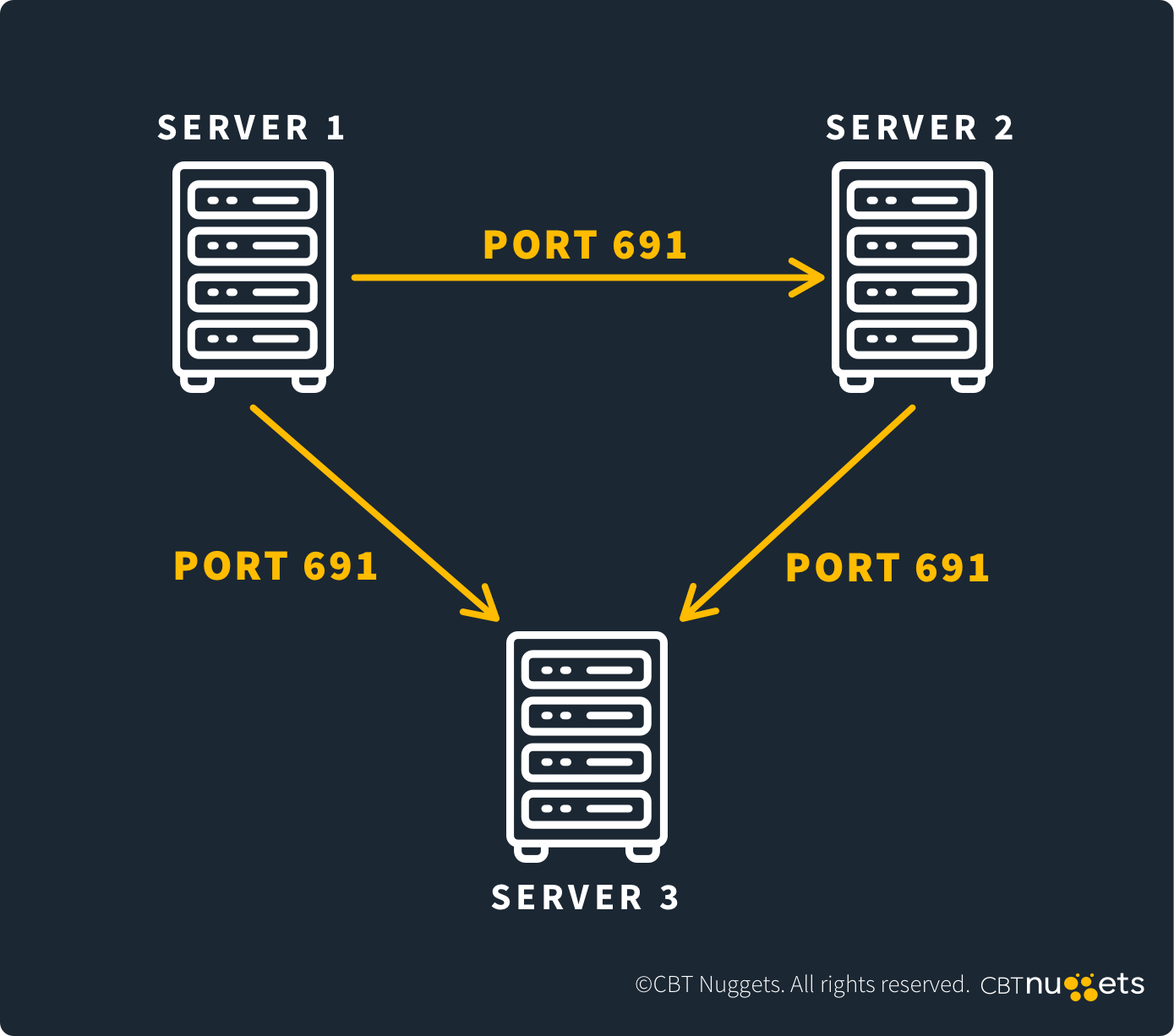What is Port 691?
by Colin Cohen | Published on July 03, 2024
Port 691 is dedicated to the Microsoft Exchange Routing Engine (RESvc) service. Exchange mail servers use this service over the port to update routing link state information so that servers can route messages quickly.
What is Port 691?
Microsoft Exchange mail servers use port 691 to maintain routing tables, which allow them to find the fastest route for delivering messages. They do this through the RESvc service, which functions over the port using TCP.
Definition and Significance
To understand the significance and purpose of port 691, you first must have a basic understanding of Microsoft Exchange. It’s a mail server that runs on Windows Server platforms that lets mail clients send and receive email.
Exchange servers, organized within routing groups, need to know how to route messages between them. They do this through the RESvc service over port 691. The service maintains routing tables that are constantly updated with link state information to provide the fastest route between servers.
Protocol Association
The RESvc service uses the Open Shortest Path First (OSPF) protocol over port 691 to maintain routing tables on Microsoft Exchange servers. This protocol uses Dijkstra’s shortest path algorithm to find the most efficient path between servers. The process is similar to how routers locate IP addresses on the Internet.
You use Transmission Control Protocol (TCP) as a transport protocol when running the RESvc service over port 691. You cannot use User Datagram Protocol (UDP) because OSPF requires a connection, and UDP is connectionless.
Uses and Functions of Port 691
You use port 691 on devices that run the RESvc service on Microsoft Exchange mail servers. They use the port to maintain routing tables, so that Exchange can know the most efficient path between servers.
Primary Uses
The primary use of port 691 is on Microsoft Exchange servers. The servers run the RESvc service to maintain routing tables that provide the fastest route between the servers. The tables are constantly updated on the servers so that routes to other servers are updated automatically with new ones in case of system failures.
Industry Use Cases
You will typically only find port 691 used in large organizations with Windows environments. Microsoft Exchange mail servers running in these environments use port 691 to maintain routing tables on the servers so that the most efficient route between them is always available.
Security Considerations for Port 691
While there are no known security risks associated with port 691, you still need to keep the port secure. You should follow best practices for keeping it secure by only opening the port when necessary and by properly securing it in your firewall.
Potential Risks
There are no known vulnerabilities associated with port 691 at this time. But that doesn’t mean you don't have to properly secure the port. You should still follow best practices for keeping the port secure.
Best Practices for Security
If you don’t have a Microsoft Exchange server running on a device, you should probably close port 691. If you are running a server on a device, you should only allow access to private addresses in your firewall. You do this as follows:
Open the Firewall Control Panel by running firewall.cpl in a command prompt.
Select Advanced Settings and click Inbound Rules.
Click New Rule under Action.
Select TCP and Specific local ports, and enter 691.
Under Action, select Allow the connection and click Next.
Under Profile, select Domain and Private and click Next.
Under Name, enter a name for the rule and click Finish.
Repeat steps 2 through 7 for Outbound Rules.
Troubleshooting and Managing Port 691
If your organization uses Microsoft Exchange, it is essential to exchange routing information between the servers using the RESvc service. Therefore, you need to check if port 691 is open on the servers. Additionally, you should be able to troubleshoot any conflicts that may arise on this port.
Detecting Issues
To determine whether port 691 is open on a device, run the following command from a Windows command prompt:
netstat -aonResolving Common Issues
Only one service can listen to port 691 at a time. If you want to run the RESvc service on port 691 and discover through the netstat command that another service is listening on this port, you will need to disable this other service before you can start RESvc.
Frequently Asked Questions
The following FAQs answer questions typically asked relating to port 691. They provide a basic understanding of the port and its uses.
What is TCP Port 691 Used for?
You use TCP port 691 on Microsoft Exchange mail servers. The servers run the RESvc service, which maintains routing tables on the servers over the port. The service lets servers know the fastest path between them.
Is Port 691 TCP or UDP?
When running the RESvc service on Microsoft Exchange servers over port 691, you are using TCP as the transport protocol. This is because the service requires a connection between the servers and UDP is connectionless.
Is It Safe to Block Port 691?
If you are not running a Microsoft Exchange server on a device, it is safe to block port 691 on it. Even if you are running an Exchange server on it, you should limit access to the port to private IP addresses.
Is Port 691 Vulnerable?
There are no current vulnerabilities associated with port 691. But you still need to keep the port secure. You can do this by following the guidelines described in the Best Practices for Security section.
Conclusion
You use port 691 on Microsoft Exchange servers. The servers run the RESvc service so that routing tables on the devices are always updated with the fastest routes to other servers. While there are no current vulnerabilities associated with the port, you still need to keep the port secure.

